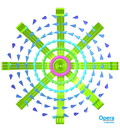text to clipboard
Clean energy pioneer to prototype fusion power plant
Cobham’s Opera Advanced Simulation Software is Helping Tokamak Energy To Develop A Pioneering Clean Energy Power Plant Based On Nuclear Fusion
Oxford, UK, December 5, 2016 – Advanced simulation software is helping Tokamak Energy to develop a pioneering clean energy power plant based on nuclear fusion. Using the electromagnetic design and analysis facilities provided by the Cobham Technical Services Opera software, critical design issues are being resolved at an early stage to help prototype an ultra-compact spherical tokamak in a tiny footprint that is about the size of a house room.
Tokamak Energy grew out of the Culham Laboratory, home of JET, the world’s most powerful operating tokamak. With the advent of high temperature superconductors (HTS), the company's founders realised that it is theoretically possible to produce a tokamak that performs similarly to existing research machines - but with a much smaller spherically-shaped reaction chamber.
The controlled fusion process inside a tokamak takes place in a plasma that is held in place by a very powerful electromagnetic field. The Cobham Technical Services Opera simulation software is helping Tokamak Energy to design this magnetic confinement system.
A key step on the path to the commercial spherical tokamak is the current construction of a working prototype - the ST40 - that will be used to prove that the extreme high temperature required for fusion reactions can be achieved inside a compact tokamak.
As part of this design step, Tokamak Energy used the Cobham Opera simulation software to assess the electromagnetically induced forces and field profile of the ST40 tokamak's magnetic confinement system. To reduce costs the prototype does not use HTS coils, but employs a single massive copper conductor for each toroidal field coil. The final HTS coils will need to be mechanically supported with minimum heat transfer. This prototype will help Tokamak Energy to investigate a self-supporting structure that is able to cope with the large internal mechanical forces generated but which minimises thermally conductive connections to the room-temperature world. A consequence of the massive copper conductors is that current density and the resulting Lorentz force density is non-uniform - necessitating a high precision simulation.
The magnetic confinement system for ST40 is around 2.6 metres high and 2.8 metres in diameter and will have 24 toroidal field coils, arranged in eight groups of three, as well as multi-turn poloidal field and central solenoid coils. Before finalising the coil designs, Tokamak Energy modelled and simulated several variations, each examining the fields and forces at different times in the operating scenario. Three dimensional simulation was employed for accuracy, using a 45 degree 'wedge' of the symmetrical spherical geometry for computational speed. Even so, the finite element design models used are extremely large in order to achieve exceptional precision - and involve around 10 million elements. These huge 3D models were simulated in around 15 hours using the Cobham Technical Services Opera software running on standard PC technology.
The ST40 is now being assembled and is due to start operating early in 2017. The initial target is to create a plasma that is hotter than the centre of the sun, and then push on to reach 100 million degrees.
Paul Noonan, R&D Projects Director for ST40 comments, “the Cobham Technical Services Opera software is helping Tokamak Energy to reduce the very high costs associated with prototyping a new fusion power plant concept. After we have built our new prototype, we hope to have assembled some profoundly exciting experimental and theoretical evidence of the viability of producing fusion power from compact, high field, spherical tokamaks”.
To speed design and prototyping, Cobham helped Tokamak Energy to build and simulate models of the ST40. Chris Riley from the Cobham Technical Services team, who worked on the engineering project adds, "Developing highly-complex and unique equipment like a tokamak would be prohibitively expensive and time consuming without the aid of advanced computer-aided engineering tools. The performance of the magnetic confinement system is critical to the operation of the spherical tokamak; we are proud to that our Opera simulation software has been chosen to support Tokamak Energy's engineering decisions."
A more detailed review of the use of the Cobham Technical Services Opera software in this application is available at http://operafea.com/blog/opera-3d-pioneer-fusion-energy-company/
The Cobham Technical Services Opera Simulation Software is one of the leading multiphysics design automation tools, used by industrial and scientific organizations worldwide. The software is available in many variants, with generic 2D and 3D finite element analysis (FEA) solvers and application-specific solvers for static and time-varying low-frequency and high-frequency electromagnetic, electrostatic, magnetostatic, structural, thermal and space charge design problems. Typical applications include the design, analysis and performance optimization of electric motors, generators and transformers, permanent, normal conducting and superconducting magnets, and charged particle devices such as magnetron sputterers, electron microscopes, X-ray machines and CT scanners.
More information:
The Cobham Technical Services Opera simulation software: operafea.com
Tokamak Energy: www.tokamakenergy.co.uk
Spherical tokamaks: youtube.com/watch?v=hWW9kE2lUqo
About Cobham The most important thing we build is trust
Cobham is a leading global technology and services innovator, respected for providing solutions to the most challenging problems, from deep space to the depths of the ocean. We employ around 11,000 people on five continents, and have customers and partners in over 100 countries, with market leading positions in: wireless, audio, video and data communications, including satellite communications; defence electronics; air-to-air refuelling; aviation services; life support and mission equipment.
About Tokamak Energy
Tokamak Energy was established in 2009 to develop small spherical tokamaks and compact fusion reactors for a range of applications. Since 2012, the strategy has evolved to prioritise building a pilot plant to exceed fusion energy breakeven: machines able to generate net energy gain for a sustained period. Tokamak Energy is particularly focused on spherical tokamaks, pioneered at Culham, because these compact devices can achieve a much higher plasma pressure for a given magnetic field than conventional tokamaks, i.e. they are more efficient. Theoretical calculations show that a spherical tokamak using high fields produced by HTS magnets could be significantly smaller than other fusion machines currently proposed. For example, a compact ST power plant would have a volume up to 100 times smaller than ITER – the successor to JET currently being built in France at an estimated cost of around €20 billion – so would be approximately room-sized rather than aircraft-hangar-sized. This development creates such a substantial commercial opportunity that the company intends to focus its efforts and resources on developing a compact spherical tokamak fusion energy source to demonstrate net energy gain. Tokamak Energy is breaking the problem down into a series of engineering challenges:
1. build a small prototype tokamak to demonstrate concept
2. build a tokamak with all magnets of high temperature superconductor (achieved in 2015)
3. reach fusion temperatures in a compact tokamak (aiming for 100 million degrees in 2017)
4. achieve energy breakeven – at least as much energy out of the machine as put in to drive fusion reactions (aiming to achieve this by 2020-2021)
5. produce electricity for the first time
Tokamak Energy is currently at stage 3 and is building a new tokamak, ST40, in Abingdon, UK. Stage 4 (energy breakeven) would be the “Wright Brothers Moment” for fusion – a distinctive technology breakthrough.
ENDS
For further information please contact:
Cobham Technical Services, Opera Simulation Software, Network House, Langford Locks, Kidlington, Oxford OX5 1LH, UK. t: +44 (0)1865 370151 vectorfields.info@cobham.com www.OperaFEA.com
Media contact: Kevin Ward, Operations General Manager
Tokamak Energy Ltd, 120A Olympic Avenue, Milton Park, Abingdon, OX14 4SA, UK. t: +44 (0)1235 355940 info@tokamakenergy.co.uk www.tokamakenergy.co.uk







 |
|